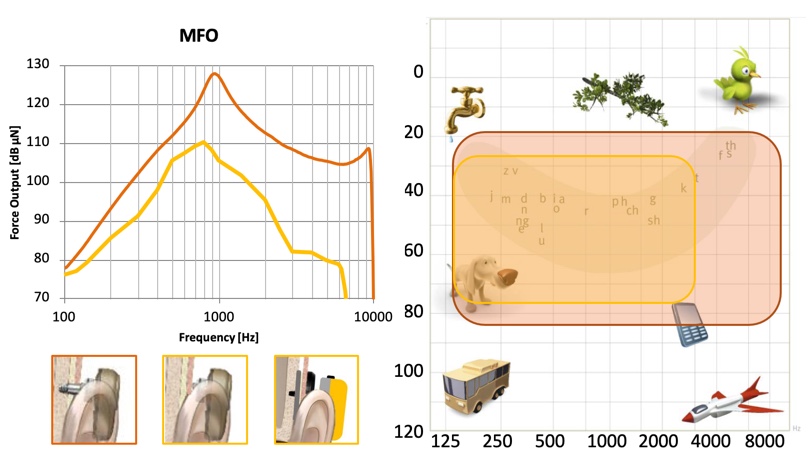Question
What are the differences between Direct Drive vs. Skin Drive?
Answer
From a performance perspective, bone anchored systems can be classified into two groups: direct drive (percutaneous) transmission options and skin drive (transcutaneous) transmission options.
As shown in Figure 1, there is significantly more output provided with a direct drive system (represented by the orange color) as compared to the skin drive (shown in yellow). The direct drive allows for increased low frequencies, for better loudness sensation and voice quality, more high frequencies for delivery of important speech signals, and also a wider frequency bandwidth for improved speech perception, sound quality, and speech in noise understanding.

Figure 1. Direct drive vs. skin drive.
Some benefits of direct sound transmission are that:
- Sounds are attenuated in skin transmission solutions, even with softband correction factors in the software.
- Direct sound transmission systems can provide an extra 10 to 20 dB of output in the mid to high-frequency range.
- The mid and high-frequency range contains the most important sound information for speech understanding.
There are some additional differences between percutaneous and transcutaneous systems.
- Direct-drive systems send vibrations via a direct route to the bone. With skin drives (such as softband, headband, test band or passive transcutaneous solutions with an implanted magnet), vibrations are sent through the skin and tissue to the bone. This suffers from skin and tissue attenuation.
- There is a minimal physical sensation of the device when the patient is wearing a direct drive system. With skin drives, there is a constant awareness of the processor due to the pressure it puts on the skin.
- With direct drives, MRI shadowing is nominal, producing about a 10-millimeter artifact. In contrast, with skin drives, MRI shadowing is significant, producing about a 150-millimeter artifact. This is important to consider when we are working with patients that may require MRIs.
- With direct drive systems, tissue preservation surgery leaves only a small post. With skin drives, surgery removes a significant area of hair, skin, and tissue (if you're using a magnetic option).
Another benefit of direct drive systems is that they offer upgradability, regardless of the possible changes in hearing.
In terms of transmission, direct drive devices are the most efficient, since no attenuation occurs from the skin and tissue dampening. A person who uses a skin drive system, due to their limited output, is at risk of missing important speech sounds. The skin and tissue absorb the energy causing a lower perceived output level. More power is needed in order to have the same perceived benefit with a skin drive device when compared to a direct drive device.
This Ask the Expert is an excerpt from the CE Course, Power for Everyone!
